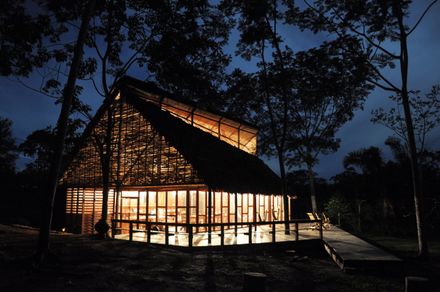Ani Nii Shobo
PREDOMINANT MATERIALS
Wood Structure Quinilla (Bidentata Manilkara), Roofing In Palm Leaf (Irapay, Shebon), Exterior Walls Quinilla And Wire Mesh,
INTERIOR WOOD PANELING
Capirona (Calycophyllum Spruceanum), Pavements In Quinilla And Shihuahuaco (Dipteryx Micrantha)
MASTER CARPENTERS
Amador Sanchez, Misael Marin
CLIENT
Ani Nii Shobo
SIZE
10,000 sqft - 25,000 sqft
BUDGET
$100K - 500K
BUILT AREA
1162m2
LAND AREA
30ha
PROJECT YEAR
2009-2014
YEAR
2014
LOCATION
Peru
CATEGORY
Educational › Other, Government + Health › Medical Facility, Hospitality + Sport › Hotel Wellness/Spa
Ani Nii Shobo, big house of the forest in Shipibo language, is a healing center and nature reserve based on the traditional medicine of the Shipibo people.
The project is located on the banks of a lagoon near the native community of San Francisco de Yarinacocha in the Ucayali region in the Peruvian Amazon.
The Ucayali river’s seasonal floods determine this landscape and its ecosystems with fluctuations of up to 8m that inundate and connect vast riverside areas.
The project consists of a series of programs that are located along this variable edge between forest and water.
The program consists of rooms for visitors a volunteer house, a house of ceremonies (longhouse), a dining room and service spaces.
It was important to preserve and value preexisting conditions, favoring the the lake view of cabins and placing the dining under a group of old Pachucos, native trees with a slender pale trunk, contrasting with the proposed volume.
The project is based on the use of local materials such as capirona and quinilla wood and irapay palm leaf roofing.
Constructive logic was sought on the observation of vernacular architecture, so that the project could be built by local craftsmen.
A structural grid that simplifies modulation was used as well as constructive solutions according to local crafts.
To fit the extremely hot and wet climate of the region, the peoples of Amazonia have developed a simple yet specific system of rules, creating a n architecture based on the use of materials in the immediate environment.
The Shipibo houses have tall roofs made of palm leaves with a steep slope which favors water runoff, while the hot air is concentrated at the top of the volume, creating a fresh and airy shade.
In this space a deck, which is both the floor and the table of the house, concentrated daily activities, resulting in meals and long conversations accompanied by craft making.
This was the role we found for the collective dining room: a large shipibo house. The dining room can be completely open or closed yielding a covered terrace with a vented skin.
Covered outdoor margins create a shaded surround for habitations and an intermediate umbral for quotidian life.
























